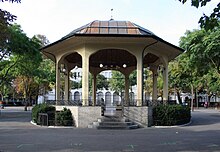Pavilion






In architecture a pavilion (from French, "pavillon", from Latin "papilio") has two main meanings.
Free-standing structure
Pavilion may refer to a free-standing structure sited a short distance from a main residence, whose architecture makes it an object of pleasure. Large or small, there is usually a connection with relaxation and pleasure in its intended use. A pavilion built to take advantage of a view is referred to as a gazebo.
Such pavilions may be small garden outbuildings, similar to a summerhouse or a kiosk. These were particularly popular in the 18th century and can be equated to the Italian casina, usually rendered in English "casino". These often resembled small classical temples and follies. A poolhouse by a swimming pool may have sufficient character and charm to be called a pavilion. By contrast, a free-standing pavilion can also be a far larger building such as the Royal Pavilion at Brighton, which is in fact a large oriental style palace; however, like its smaller namesakes, the common factor is that it was built for pleasure and relaxation.
A sports pavilion is usually a building adjacent to a sports ground used for changing clothes and often partaking of refreshments. Often it has a verandah to provide protection from the sun for spectators. The term pavilion is also used in stadia, especially baseball parks, to distinguish a typically single-decked, covered seating area from the more expensive seating area of the main grandstand and the less expensive seating area of the uncovered bleachers.
Classical architecture
In its other main significance, in a symmetrical range of buildings in the classical styles, where there is a main central block—the corps de logis—the wings may end in pavilions that are emphasized in some fashion, in order to provide a full stop to the composition, like a period at the end of a sentence.
In the Place des Vosges, Paris (1605–12), twin pavilions mark the centers of the north and south sides of the square (illustration, left). They are named the Pavillon du Roi and the Pavillon de la Reine though no royal personage ever lived in the square. With their triple archways, they function like gatehouses that give access to the privileged space of the square. French gatehouses had been built in the form of such pavilions in the preceding century.
In the country, a Pavilion is an architectural place used for hunting. The "Pavillon de Galon" in Luberon (France) is a typical 18th century hunting aristocratic pavilion. The pavilion located on the place of an old Roman Villa includes some gardens "à la française" which was used by the guests for receptions.
See also
![]() Media related to Pavilions at Wikimedia Commons
Media related to Pavilions at Wikimedia Commons
